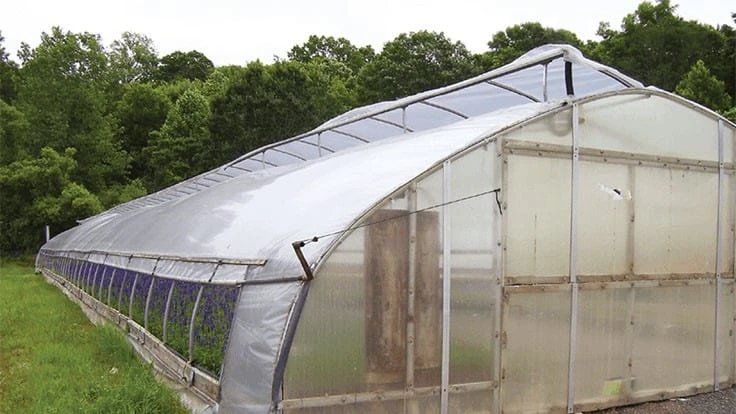

Summer’s electric bills can be more expensive than winter’s with greenhouse cooling as the main use. Putting the following tips into practice can help reduce the useage.
Shut down greenhouses not in use
I frequently see ventilation equipment operating in an empty greenhouse. Turn exhaust and HAF fans off and open all vents, doors and rollup sidewalls. Use exterior or interior shade to reduce the inside temperature.
As exhaust fan ventilation is installed at 8 cubic feet per minute (cfm)/square foot floor area, it uses an estimated 0.4 to 0.6 kilowatt hours (kWh) of electricity per 1,000 square feet of floor area each hour. If operated 16 hours in a 10,000 square-foot facility, this would add from 64 to 96 kWh to the electric bill each day.
HAF air circulation fans are also frequently left operating. These are typically installed at about 2 cfm/square foot of floor area and, depending on model use, from 0.07 to 0.2 kWh/1,000 square feet. For 24 hours/day operation, this can add another 17 to 48 kWh/day to the above greenhouse electric bill.
Exhaust fans benefit from frequent maintenance
If the belt squeals when the fan starts, it is either loose or worn. To check the belt for proper tension, press in the center between the pulleys. It should only move a distance equivalent to the belt’s width. A belt with cracks or frayed edges should be replaced.
Shutters should operate smoothly. Examine for bent or stuck open shutters and lubricate bearings and levers when needed. Clean the fan blades and motor frequently. The layer of dust reduces air flow over the blades. Dirt on the motor traps heat and leads to overheating.

HAF fan maintenance is important in achieving high efficiency
Fan blade guards and motor casings pick up considerable dust from the air moving past them. It is important to clean these several times a year. Since fans frequently get moved out of position, they should be restrained by a bracket or chains to keep them stable.They should also be located to point horizontally towards the opposite endwall to transfer maximum energy to the air mass.
Turn hoizontal air flow fans off when exhaust fans are on or if vents are open
The horizontal air flow (HAF) disrupts the normal exhaust fan or natural ventilation air flow pattern decreasing ventilation efficiency. Install a relay that disconnects HAF when the ventilation system is activated.
Add a roof vent
To reduce electricity use, some growers are installing roof vents in their hoophouses. A 4-inch wide vent on the summer leeward wind side should be adequate with rollup sides. This allows heated air to escape through the roof, eliminating the need for exhaust fans. It also provides a more uniform temperature throughout the greenhouse. The cost of a motorized roof vent is $50 to $60/linear foot. In some states, the USDA NRCS – EQIP program provides grants for installing roof vents. Select an open roof design when building a gutter-connected house to eliminate the initial and operating costs of fans.
DON'T TRY TO OVER-COOL THE GREENHOUSE BECAUSE THE FANS WILL HAVE TO RUN MUCH LONGER TO GET THE LAST DEGREE OF COOLING.
Be realistic when setting the cooling control
Don’t try to over-cool the greenhouse because the fans will have to run much longer to get the last degree of cooling. To prevent short circuiting of the air, keep doors and vents near the fan closed. The control sensor should be located near the center of the greenhouse at plant height and shaded from direct sunlight.
Select high-efficiency replacement motors
Many older fan motors are in need of replacement. Although premium motors with 86% efficiency cost a little more than standard motors, they draw less current.
For example, a new premium 1 horsepower motor draws only 9.2 amps compared to an original capacitor start motor that draws 13.6 amps, which is a 32% savings in electricity. Premium motors also have shaft and bearing seals that keep out dust and dirt, moisture resistant grease and electronic control. Check with your local Natural Resources Conservation Service (NRCS) office about funding to replace the motors.

Explore the April 2020 Issue
Check out more from this issue and find your next story to read.
Latest from Greenhouse Management
- 2025 Proven Winners Horticulture Scholarship applications now open
- How to improve inventory and shipping management in the greenhouse
- Leading Women of Horticulture: Anna Ball, Ball Hort, and Terri McEnaney, Bailey Nurseries
- GM CEA HERB Part 2: A guide to increasing the sowing density of culinary herbs
- GM CEA HERB Part 1: Best practices for producing culinary herbs in controlled environments
- USDA fires experts on invasive pests, including Asian citrus psyllid, chilli thrips
- CEA Alliance celebrates bipartisan introduction of Supporting Innovation in Agriculture Act
- Dümmen Orange North America celebrating 25th anniversary in 2025





